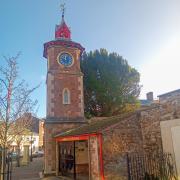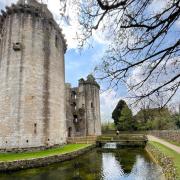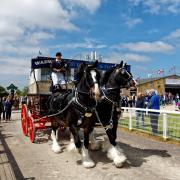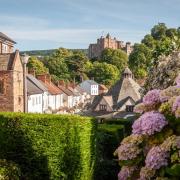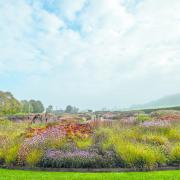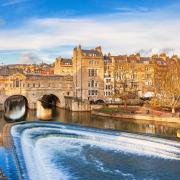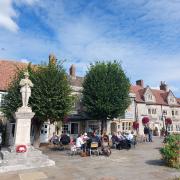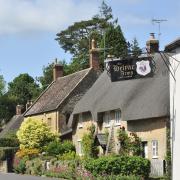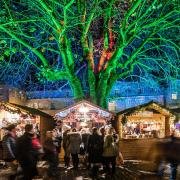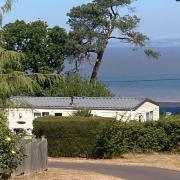With its heather-rich moorlands, deep wooded valleys and dramatic coastline, there’s every reason to make a journey to Exmoor National Park, says Catherine Courtenay
Exmoor has always been about ‘real people living real lives’, says Emma Thomasson CEO of Visit Exmoor.
Its villages can be enjoyed in any season and they’ve each got their own character which makes them special, she adds.
‘Places like Porlock, Minehead, Dunster and Dulverton have so much to offer, from food and drink to shops and walks. They are all great for a mooch around,’ she says.
‘There’s a vibrancy and also a warm welcome that’s here all year round,’ she says.

Wheddon
Emma’s colleague Cally Elston moved to the village of Wheddon Cross, about a year ago. Being the highest village on Exmoor, the weather naturally affects daily life for those who live there. ‘The climate can be very different on the moor to the coast, we are often a few degrees cooler. The morning mists on the moors can be a pretty amazing sight to wake up to.'
Cally and Emma will tell you that locals are aware of the importance of supporting both village businesses and village life too. It may explain why there are so many village pubs and shops in moorland villages, despite them disappearing from other parts of the country.
‘Each place has its own unique character and charm, and most have a village pub and shop which have seen people thought these difficult times and are quite a focal point for the community,’ says Cally.
There’s a ‘buy local and support local’ culture on the moor, says Emma, but visitors are also vitally important to these communities.
‘Across Exmoor about 60 per cent of all our employment is dependent on the visitor economy. Almost every home has some linkage to the visitor economy as well - which is why we welcome people.’
Dulverton

Known as the southern gateway to the moor, and home to the National Park Authority HQ, Dulverton has long been a focal point of activity for both locals and visitors. It’s home to the oldest medieval bridge on Exmoor, across the River Barle, and at the top end of town is the pretty 15th century Church of All Saints.
In between are streets that contain around 40 independent shops, businesses, tea rooms and restaurants, including a Thai restaurant with rooms, the Tongdam Thai and the famed Woods Bar and Restaurant, a pub with menus that are truly field to fork (the landlord has his own farm).
Hours can be spent in its shops, which include gifts, antiques and home furnishings. A shop to really lose yourself in is Rothwell & Dunworth antiquarian and second-hand books. Seven Fables is another ‘don’t miss’ shopping experience with its exquisite, and magical, range of work by artists and makers – from books to prints, ceramics, jewellery and clocks.
Home to one of Exmoor National Park’s information centres, Dulverton also a good starting point for finding out more about Exmoor’s activities and events.
Porlock

Surely everyone has heard of Porlock Hill? One of the steepest main roads in England, it’s long been the ‘hill of legends’ for local families and those of us who’ve driven up its windy, and steep, ascent. The views from the top, mind you, are awe-inspiring. At the bottom is Porlock itself, a busy village set in the heart of Porlock Vale.
A walk along its High Street is a treat, and offers many places to sit for a while, with tea and cake. There are gifts, antiques and crafts to uncover and it’s also home to tea and coffee merchants, D J Miles and Co which has a shop next to its coffee roastery in the village.
Porlock is a good base from which to explore, by foot, bike or boat, the Porlock Vale area, including its expansive salt marsh, now designated a Site of Special Scientific Interest (SSSI).
Dunster

History and heritage flow through the streets of this Exmoor village, which is one of the best-preserved medieval villages in England. Overlooked by National-Trust owned Dunster Castle, it’s packed with interesting historic features, including the remains of a Benedictine priory. a dovecote, a watermill, Iron Age settlements, a medieval packhorse bridge and, at its centre, the much-photographed Yarn Market.
Its church is worth a visit too, if only to see another record breaker – the rood screen is the longest in England. After exploring its busy streets, you could escape to the Buttercross community orchard and picnic area where there are several unique Dunster plum trees. On a less warm day, there’s the Luttrell Arms where you can get a bite to eat in impressive historic surrounding, or for a special meal visit Reeves for fine dining with a neighbourhood restaurant feel.
Exford

This spacious feeling village, thanks to its large village green, is set around the River Exe in the heart of the moor and is a perfect base point for exploring the surrounding countryside – whether that’s walking, riding or cycling. It has two large pubs, The Crown Hotel and the White Horse Inn as well as a village stores.
Head to The Exford Bridge Tearooms for lunch or, of course, a cream tea – and if you get there early, you can pop in for breakfast. There are plenty of places to stay in Exford and for a late-night winter’s treat, you can sample one of the 200 or so whiskies behind the bar at the White Horse.
Withypool

One of the best ways to approach Withypool is by driving over the remote expanse of Withypool Common; it gives a real sense of what makes Exmoor special, particularly when you leave the ‘wildness’ and arrive in the little village with its old stone bridge over the River Barle. This is another excellent spot for exploring the moor, with beautiful waking routes along the Barle to Tarr Steps or Landacre.
Any supplies can be found at the well-stocked village shop, with its the 1950s petrol station pumps out front.
The Royal Oak is a welcome port of call, for both food and accommodation, and it has a remarkable list of former guests, including the artist Alfred Munnings, who had a studio in the loft, RD Blackmore who wrote sections of Lorna Doone while sitting in the bar, and General Eisenhower, who apparently planned the D-Day landings while staying at the pub.
From spring to autumn, The Withypool Tearooms are another top spot for weary travellers looking for a bite to eat and drink.
Simonsbath

Simonsbath may be small but it’s an extremely popular spot for exploring the moor, with wonderful walks along the Barle Valley. It has an interesting history, despite being a relatively ‘new’ settlement on Exmoor. Its appearance is mostly due to the industrialist John Knight who arrived in the 1820s having bought the surrounding ‘Forest Of Exmoor’ and went on to develop what was a tiny settlement into his estate.
It’s home to St Luke’s Church, the main venue for the annual, Exmoor-wide, Simonsbath Festival, and the Simonsbath House hotel as well as the Exmoor Forest Inn which has this year come under new ownership.
Minehead

Not technically part of Exmoor National Park, Minehead is still seen as the eastern gateway to the moor. It’s the town that marks the start of the South West Coast Path, which has a beautiful stretch along the Exmoor coastline.
The wooded North Hill to the west of town, above the old harbour, really marks the beginning of the moor, but look in the other direction to see the wide expanse of beach and the coastal panorama that gives Minehead its character. It’s a traditional seaside town and going away from the beach along the Avenue is where to find most of its shops.
The old harbour is worth exploring too and the sight, and sound, of a steam train is another iconic Minehead feature - the town is the terminus of the West Somerset Railway, the longest heritage railway in the country.




